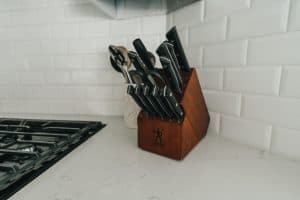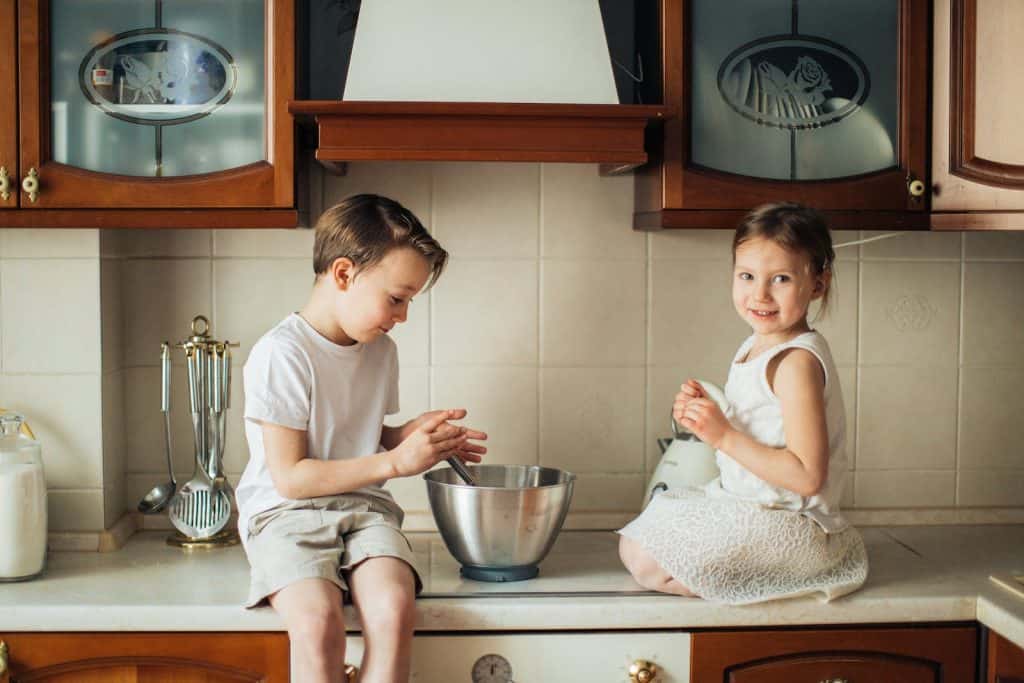Making the kitchen a safe space for kids is a top priority for any family. It’s the heart of the home but also a hotspot for potential hazards. Whether your little ones are culinary curious or just passing through, ensuring their safety is crucial.
If you’re worried about your child’s access to the kitchen, or if safety gates aren’t a foolproof solution, you’re not alone. I’ll share simple yet effective tips to transform your kitchen into a child-friendly zone. Let’s dive into making the most dangerous room in the house a safer place for our little chefs-in-training.
Identifying Potential Kitchen Hazards

When it comes to kitchen safety for kids, the first step is identifying what could go wrong. It’s essential for child safety in the kitchen to stay vigilant about the possible dangers that lurk in the very place where we whip up our meals. As a parent, I’ve realized it takes more than just a keen eye to reduce the risk of accidents.
Child Safety in the Kitchen: What to Watch Out For
Ensuring chair safety in the kitchen starts with a critical evaluation of the environment. The stove, undoubtedly, poses a significant risk. Stove safety is not just about preventing burns but also ensuring kids can’t access knobs or hot surfaces. Similarly, hot food can cause just as much damage if it’s within easy reach of a child. I always make sure pot handles are turned inward and use back burners when possible.
Preventing burns isn’t just about the stove, though. Appliances like food processors or toasters should be kept unplugged or far from the edges where little hands can grab. And it’s not just about heat – sharp utensils can turn a fun helping session into a trip to the ER. I’ve found installing a simple childproof latch can restrict access to knife drawers and provide peace of mind.
Furthermore, kitchen hazards aren’t always about immediate injury. Raw meat, for instance, carries bacteria that could cause food poisoning. I ensure it’s stored properly and that any surface it touches is cleaned immediately. And then there’s the issue of fire. To mitigate this risk, I have a functional fire extinguisher accessible and ensure my kids are aware of basic kitchen safety rules.
Also, I never underestimate the allure of what’s forbidden – items like cleaning supplies and alcoholic beverages are always locked away. And those adorable oven mitts? They’re crucial when teaching kids about handling hot food and preventing burns, but they too should be stored out of reach when not in use to avoid misuse.
In essence, creating a childproofing kitchen strategy requires attention to detail and a proactive approach. The safety of my little ones has always been paramount, and by understanding and addressing kitchen hazards, I help create a space where culinary exploration is both safe and encouraged.
Safe Storage of Sharp Objects and Chemicals

When it comes to kitchen safety, one of the fundamental steps I always recommend is addressing how to store sharp objects and toxic chemicals. This can’t be overstated; childproofing your kitchen is essential for preventing accidents. Every year, numerous children are treated for incidents related to these hazards, making it a high priority for any safety-conscious parent or caregiver.
Keeping Chemistry Away from Curiosity
To uphold child safety in the kitchen, it’s vital to keep all household chemicals, including cleaners and medicines, secured. I install safety locks or use high shelves that are out of the reach of little hands. To give an idea of the scale of this issue, over 28,000 children visit the emergency room for poisoning accidents annually. Even more pressing is that many of these incidents involve everyday kitchen cleaning agents. Here are some steps I follow for safe storage:
- Choose the least toxic cleaning products available.
- Never repurpose food containers for storing chemicals.
- Install safety locks on cabinets where chemicals are stored.
- Consider a lockable trash bin or secure the lid to prevent access.
Sharp Practices for Child Safety in the Kitchen

Knives and other sharp utensils can pose a serious risk of injury. Ensuring the safety of kitchen tools is a task I take seriously by:
- Storing knives in locked drawers or on magnetic strips out of children’s reach.
- Using safety latches on drawers even if you think they’re out of reach, as some little ones might surprise you with their climbing abilities.
- Making sure food processors and other cutting devices are always disassembled and locked away when not in use.
Stove Safety and Appliance Security
Stove safety is another major component of a childproof kitchen. Preventing burns and ensuring the security of heavy appliances is part of creating a safe environment. Here’s my checklist:
- Secure free-standing stoves to walls to avoid tip-over accidents.
- Use child locks on your oven.
- Check for stove knob covers to prevent the turning on of burners.
By implementing the kitchen safety rules I’ve outlined here and throughout this article, you’ll make great strides in safeguarding your kitchen against kitchen hazards like sharp objects and harmful chemicals. Remember, it’s not just about locking away the dangerous items; it’s also about nurturing your child’s exploration in a safe, controlled environment.
Childproofing Appliances and Electrical Outlets
Ensuring child safety in the kitchen extends beyond careful monitoring; it’s about adapting the environment to minimize risks inherently. That’s where childproofing appliances and electrical outlets comes into play.
Embracing Child Safety in the Kitchen with Appliance Security
Kitchen safety starts with aware appliance use. To avoid the hazards associated with electricity in the kitchen, I always keep electric flexes wrapped neatly and out of reach, using bread ties or opting for appliances with coiled flexes for added safety. When shopping for new appliances, models featuring child-safe designs, such as cool wall kettles and toasters, are a priority.
With technology advancing, I don’t overlook the simple yet effective solutions such as fitting appliance safety catches on ovens and microwaves. These catches ensure these appliances remain closed when not in use, thus, preventing burns and unwanted accidents.
- Appliance safety tips include:
- Using child-proof covers for sockets
- Securing bins and dishwashers when not in use
- Keeping oven doors closed at all times
- Selecting cordless kettles when possible
- Removing gas hob dials or using knob covers to enhance stove safety
Kitchen Electricals: Achieving Kitchen Safety Beyond the Stove

Away from stove safety, securing electrical items is vital. I make sure to unplug appliances after use, a habit that pays off in preventing curious little hands from turning them on. Notably, for items with sharp components like food processors, storage out of children’s reach is non-negotiable.
Unraveling essential yet often overlooked childproofing kitchen tips, the trash can is a common oversight. Ensuring that it’s either hidden or equipped with a locking lid keeps children safe from kitchen hazards like raw meat and other garbage. Similarly, I’ve mounted my microwave out of reach and kept it unplugged when idle. For those with a garbage disposal, a switch protector is a wise investment, coupled with drain covers to protect against lost items.
Ultimately, blending these kitchen safety rules into daily life creates a safer, more inviting space for children to explore culinary wonders without the lingering risks of kitchen hazards.
Creating a Designated Play Area Within the Kitchen
Maintaining kitchen safety requires a proactive approach, especially when it involves children. While I’ve covered topics from stove safety to preventing burns, an often overlooked aspect is the establishment of a designated play area within the kitchen. This strategy doesn’t just minimize the risk of accidents but also integrates child safety in the kitchen into the overall design of the space.
Prioritizing Child Safety in the Kitchen
The first step is to identify an area that’s naturally safe for kids—a space away from hazards such as hot food, raw meat, and especially heat sources which can lead to burns. I ensure that this zone is free from loose cords that could cause appliances to fall. Knife blocks are moved out of reach, and anything that could potentially harm my little ones is secured or stored away, including oven mitts, food processors, and other small appliances.
After securing potentially dangerous items, marking the boundaries of the play area becomes critical. I use brightly colored tape on the floor to outline where kids can safely play and use visual cues to reinforce kitchen safety rules. These clear boundaries help children understand where they can be involved and safe, while I prepare meals.
For toddlers who are drawn to the kitchen’s hustle and bustle, it’s important to keep their curiosity at bay with engaging activities in their designated area. Simple culinary tasks like washing vegetables or stirring batter can be a safe way to involve them, keeping their hands busy and their minds focused away from kitchen hazards.
However, if the kitchen activity is too intense, or if younger children are too small to understand the dangers, I recommend utilizing baby-proofing gates. This not only physically restricts access but also mentally reinforces the notion that the kitchen isn’t always a play area, thereby cementing the necessary understanding of fire and safety protocols without words.
I always remember that a well-organized kitchen is a safer kitchen, and ensuring there’s a place for everything—and that everything is in its place—reduces the chances of accidents. By including my children in the cleaning-up process, I’m teaching them the value of a tidy space and preventing needless clutter that could lead to slips or falls.
Teaching Age-Appropriate Kitchen Safety Rules

While fostering culinary curiosity in children, I prioritize kitchen safety. It’s crucial to teach age-appropriate behaviors to make sure kids know how to navigate the kitchen environment safely.
Integrating Child Safety in the Kitchen
For the youngest chefs, aged 3-6 years old, I emphasize the basics. We start with simple hygiene like washing hands before food preparation. Clear boundaries—like no touching the stove or oven—help keep them from harm’s way. I always remind them to stay a safe distance from hot food and appliances, a fundamental part of preventing burns.
As children grow, the kitchen safety rules evolve. Ages 7-12 may begin to handle more complex tasks. Under close adult supervision, they can learn to use childproof kitchen tools. I make sure they understand why we always turn pot handles inward and the dangers posed by oven mitts that aren’t stored properly. It’s a step-by-step process to instill good habits while still allowing hands-on experience.
Progressing to junior chefs, those between 12-15 years old, I focus on stove safety and the proper handling of raw meat to avoid cross-contamination. At this stage, kids are ready to learn more about fire emergency protocols, like the location and use of a fire extinguisher, and the safe handling of food processors.
Childproofing the kitchen is an ongoing process, as each child’s abilities and understandings develop. They must know where potential kitchen hazards lie and how to avoid them. By pairing these lessons with practical application, such as correct knife usage, I drive home the importance of safety. “Only grown-ups can grab and carry knives,” I often say and “An adult must supervise any knife work or chopping.”
To keep these lessons fresh, we often revisit the kitchen safety rules to ensure they remain second nature. Regularly checking in on their knowledge and providing gentle reminders about the dangers of hot surfaces or the correct way to handle utensils helps maintain a vigilant stance on safety.
Final Thoughts on Child Safety in the Kitchen
Ensuring your child’s safety in the kitchen is a vital responsibility that never ends. It’s about being proactive, teaching them the rules, and making adjustments as they grow. I’ve shared the importance of recognizing hazards and the practical steps you can take to mitigate them. Remember, childproofing is a journey, not a one-time task. By instilling good habits and reinforcing safety knowledge, you’re setting the stage for a lifetime of healthy, safe cooking experiences for your little ones. Stay vigilant, stay informed, and most importantly, enjoy the process of watching your child become a confident kitchen helper. Together, we can create a safer environment for our children to learn, grow, and explore the culinary world.
Other suggested articles:

